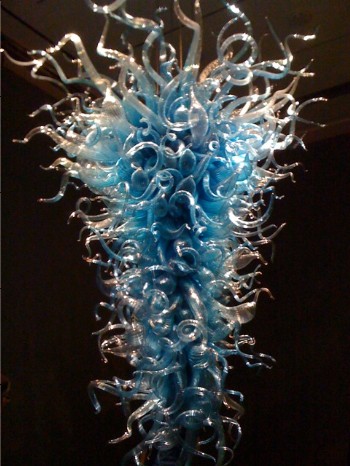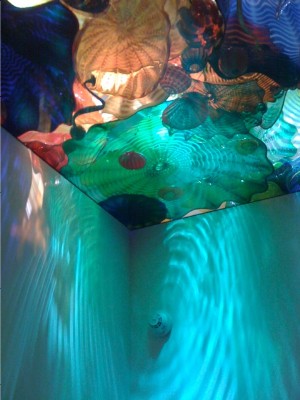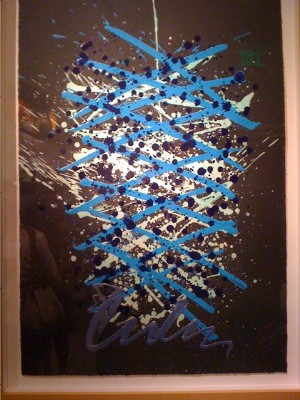Visual Arts Review: Chihuly’s Magic Glass — Testaments to the Beauty of Vivacity
“Through the Looking Glass” is a glorious celebration of American fine art and a much-needed boost to the MFA’s Americas wing collection. Amid the drab puritanical portraits and the remarkably unremarkable display of colonial dressers, Chihuly’s glassworks are testaments to the beauty of vivacity.
Chihuly: Through the Looking Glass. At the Museum of Fine Arts, Boston, MA, through August 7, 2011.
By Yumi Araki
It’s been over a month since glass sculptor Dale Chihuly’s exhibit Through the Looking Glass went on display at Boston’s Museum of Fine Arts (MFA), but hoards of curious visitors continue to queue up in the Shapiro Courtyard to take in this dynamic installation of Chihuly’s masterpieces.
I went on a Saturday, a cold and rainy May day, but as my pal and I entered the busy courtyard we encountered energizing warmth irradiating the space in the shape of a magnificent, 42-foot high, lime green glass tree. The vitality of this auxiliary installment was reinforced by the zest of another auxiliary piece — coils of colorful glass planted alongside lush stalks of tall grass— that decorated the space between the courtyard and the adjoining building. The rows of glass and grass paired seamlessly: the two mimic each other in a Zen-like harmony.
These installments set up what is to come: an exhibition that artfully explores the unique interplay between Chihuly’s glassworks and their environment, transporting visitors into mystical spaces re-imagined via the medium of glass.
Through the Looking Glass aptly embodies Chihuly’s signature approach—using glass as an artistic lens to make an allegorical point. Ikebana Boat (2011) achieves this dynamic interaction via energetic twists and coils of flowers, jungle vines, and mystic, glass fauna that spill out of a wooden vessel. In fact, each piece of glasswork surpasses its real-life counterpart, with Chihuly amplifying the traditional Japanese art of flower arrangement (ikébana) with his lusciously saturated, glass edifices. They’re illuminated by strategically placed spotlights that bounce off each contour and hue, producing an intriguing psychedelic glow. It’s as if the glass pieces join together to produce a combined luminescence, lighting up the dark walls of the exhibition space.
Persian Ceiling (2011) evokes a different kind of light show, as the artist shifts our gaze towards a transparent ceiling. Large starfish, sea anemone, and other vibrant marine figures lay atop the Plexiglas sky, casting bold, saturated rays into the white room. This light evokes the visual sensation of being underwater but with an inverted twist: the glass reef of tropical sea life lay above us; we are submerged under their shadows.
In Mille Fiori (2011) Chihuly reinterprets the traditional Venetian aesthetic commonly found on pendant heads or vases, arranging his glass flora and fauna on a three-dimensional canvas rather than a flat mosaic. As the title suggests, millions of over-sized vines, bulbous flowers, and enchanted leaves spring from a jet-black platform that spans the length of the room.
It’s not surprising that Chihuly explores the relationship between glass and its surroundings since the artist began his career in interior design and architecture. Chihuly’s mastery of an art attributed to the Venetians, though, is unexpected. Chihuly is American and developed his craft at art institutions nationwide, including several in New England. In fact, it was at the Rhode Island School of Design where the artist began evolving his distinctive environmental works using neon, argon, and blown glass. But to admire Chihuly’s macro technique, his ambitious examination of glass and space, would be to overlook the artist’s conscientious attention to detail.
It wouldn’t have been unreasonable for the artist to compromise detail given the sheer number of sculptures involved in the exhibition, but a close look (and slight squint) reveals that each piece harbors its own idiosyncratic identity. Each flower, vine, and blade of grass displays a remarkably diverse array of textures and designs that mimic nature’s geometry.
What looks like a bouquet of unassuming glass flowers is actually a pod of calla lilies sprinkled with pink glass droplets. These glass beads contribute a tangible “organic” touch, adorning the pedals like mildew or possibly pollen resin. The adjacent calla lily possesses a spotted yellow design, which is embedded in the glass and glistens under the light.
In 1976 Chihuly was injured in a car accident, leaving him blind in one eye (hence, his eye patch, which only adds to the artist’s mysterious persona). Three years later he permanently damaged his left shoulder in a body surfing accident. But he has found a way to surmount these challenges to his creativity, conveying his designs through paintings that are realized in glass by a team of craftsmen under his direction.
As an apprentice filmmaker, I feel a special connection and appreciation for Chihuly’s creative process. In the exhibition’s introduction, the artist describes himself as the director who works with a team of gaffers who serve as his hands and feet. In film production a gaffer refers to the head engineer who executes the director’s vision on set. Just as a gaffer materializes a scene out of stage notes and sketches, Chihuly’s gaffers translate two-dimensional brush stroke abstractions into three-dimensional glass pieces.
The synergy of this director-gaffer relationship is particularly evident in Chihuly’s chandelier installments. No other piece mimics Chihuly’s paintings, which serve as blueprints for his glasswork, better than Chiostro di Sant’Apollonia Chandelier (2011). A majestic symphony of sky blue ribbons, swirls, and coils, this piece bears striking resemblance to its acrylic painting counterpart, which is a sight to behold in its own right. With its volatile blue strokes and chromatic splatters, Chiostro pays eye-popping homage to its acrylic painting origins.
Chihuly can’t always participate in the physical creation of his work, but I would defend his method against detractors because it is an extension of his aesthetic. Chihuly co-produced many of the exhibition’s installations with the master Italian glassblower, Lino Tagliapietra, and in a video about his experience working with a partner, Chihuly notes that “all I have to do is make a drawing, put it up on the wall next to the furnace, and Lino interprets it. And he always interprets it in his own way, so there’s a lot of creativity from Lino and the other people on the team.”
What makes Chihuly’s glasswork inspirational isn’t just his novel exploration of glass in different spaces and settings; it’s also how his work reflects an innovative collaborative artistry, a team made up of artist, gaffers, and other glass masters.
Through the Looking Glass is a glorious celebration of American fine art and a much-needed boost to the MFA’s Americas wing collection. Amid the drab puritanical portraits and the remarkably unremarkable display of colonial dressers, Chihuly’s glassworks are refreshing testaments to the beauty of vivacity.





